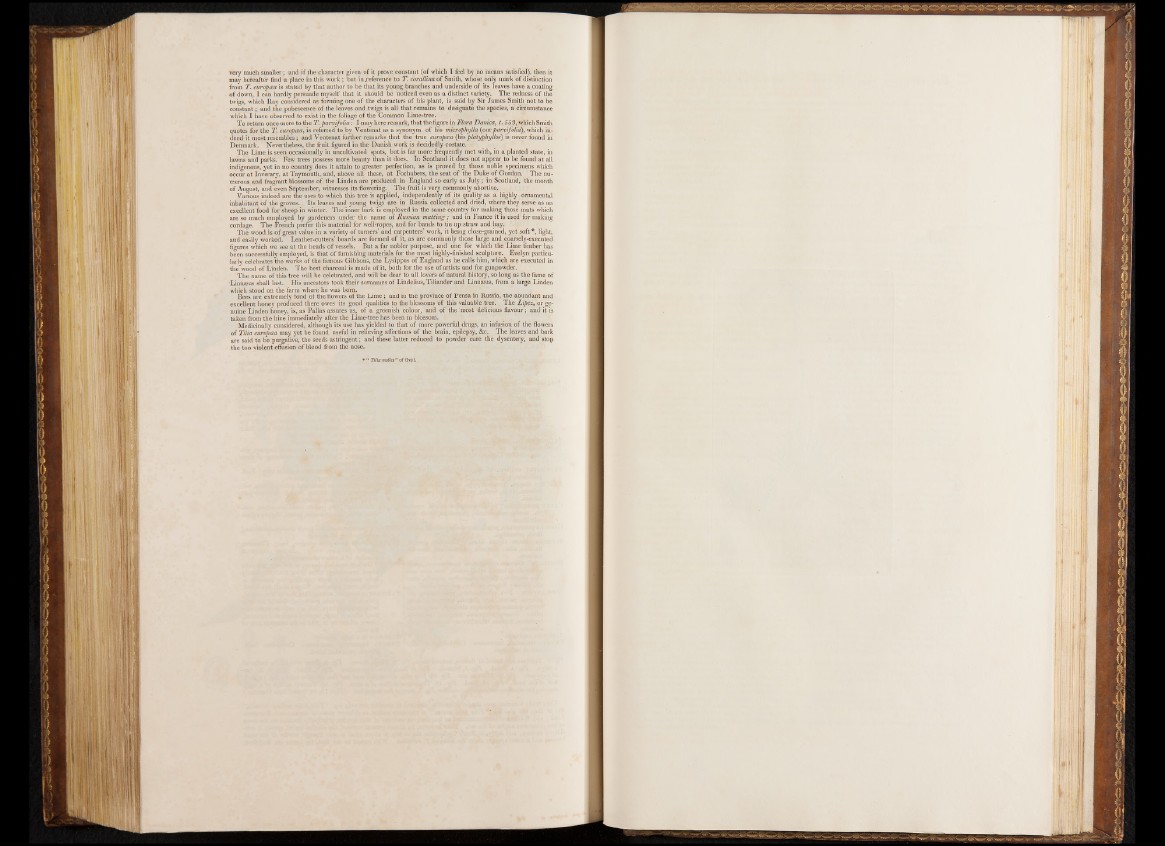
very much smaller; and if the character given of it prove constant (of which.I feel by no means satisfied),' then it
may hereafter find a place in this work ; but in .reference to T. corallina of Smith, whose only mark of distinction
from T. europaa is stated by that author to be that its young branches and underside of its leaves have a coating
o f down, I can hardly persuade myself that it should be noticed even as a distinct variety. The redness of the
twigs, which Ray considered as forming one of the characters of his plant, is said by Sir James Smith not to be
constant; and the pubescence of the leaves and twigs is all that remains to designate the species, a circumstance
which I have observed to exist in the foliage of the Common Lime-tree.
To return once more to the T. paroifolia: I may here remark, that the figure in Flora Danica, t. 553, which Smith
quotes for the T. europaa, is referred to by Ventenat as a synonym of his microphylla (purparoifolia), which indeed
it most resembles; and Ventenat further remarks that the true europaa (hisplatyphyllos) is never found in
Denmark. Nevertheless, the fruit figured in the Danish work is decidedly costate.
The Lime is seen occasionally in uncultivated spots, but is far more frequently met with, in a planted state, in
lawns and parks. Few trees possess more beauty than it does. In Scotland it does not appear to be found at all
indigenous, yet in no country does it attain to greater perfection, as is proved by those noble, specimens which
occur at Inverary, at Taymouth, and, above all these, at Fochabers, the seat of the Duke of Gordon. The numerous
and fragrant blossoms of the Linden are produced in England so early as July; in Scotland, the month
o f August, and even September, witnesses its flowering. The fruit is very commonly abortive.
Various indeed are the uses to which this tree is applied, independently of its quality as a highly ornamental
inhabitant of the groves. Its leaves and young twigs are in Russia collected and dried, where they serve as an
excellent food for sheep in winter. The inner bark is employed in the same country for making those mats which
are so much employed by gardeners under the name of Russian matting; and in France it is used for making
cordage. The French prefer this material for well-ropes, and for bands to tie up straw and hay.
The wood is of great value in a variety of turners’ and carpenters’ work, it being close-grained, yet soft *, light,
and easily worked. Leather-cutters’ boards are formed of it, as are commonly those large and coarsely-executed
figures which we see at the heads o f vessels. But a far nobler purpose, and one for which the Lime timber has
been successfully employed, is that of furnishing materials for the most highly-finished sculpture. Evelyn particularly
celebrates the works of the famous Gibbons, the Lysippus of England as he calls him, which are executed in
the wood of Linden. The best charcoal is made of it, both for the use o f artists and for gunpowder.
The name of this tree will be celebrated, and will be dear to all lovers of natural history, so long as the feme of
Linnffius shall last. His ancestors took their surnames of Lindelius, Tiliander and Linnasus, from a large Linden
which stood on the farm where he was born.
Bees are extremely , fond of the flowers of the Lime; and in the province o f Pensa in Russia, the abundant and
excellent honey produced there owes its good qualities to the blossoms of this valuable tree. The Lipez, or genuine
Linden honey, is, as Pallas assures us, of a greenish colour, and of the most delicious flavour; and it is
taken from the hive immediately after the Lime-tree has been in blossom.
Medicinally considered, although its use has yielded to that of more powerful drugs, an infusion of the flowers
of Tilia europaa may yet be found, useful in relieving affections of the brain, epilepsy, &c. The leaves and hark
are said to be purgative, the seeds astringent; and these latter reduced to powder cure the dysentery, and stop
the too violent effusion of blood from the nose.
1 Tilia mailt* " of Ovid.